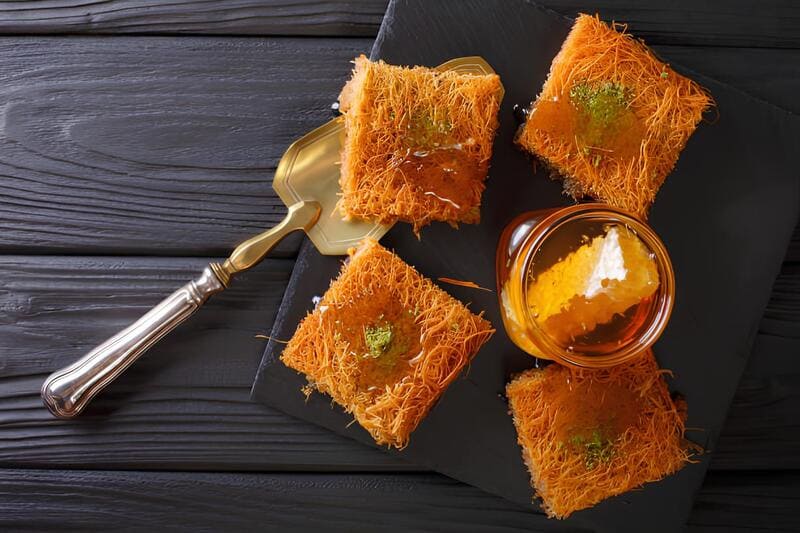
Kunafa, also known as knafeh, is an iconic dessert that holds a prominent place in Middle Eastern and particularly Egyptian cuisine. With its origins traced back to the Fatimid dynasty, this beloved pastry boasts a divine combination of shredded phyllo dough, soaked in sweet syrup, and often filled with nuts or cheese, making it a must-try delicacy.
Kunafa is cherished for its contrasting textures—the crispy exterior pairs beautifully with its soft, gooey interior. This dessert is particularly popular during Ramadan when it graces tables after Iftar. The interplay of buttery dough and a sweet, fragrant syrup creates an indulgent experience celebrated throughout generations.
Ingredients
- 500g kunafa dough
- 1 cup ghee, melted
- 2 cups sugar
- 1 cup water
- 2 tablespoons honey
- 1 tablespoon lemon juice
- 1 teaspoon vanilla extract (optional)
- 1 cup mixed nuts, chopped finely
Preparation
- Preheat your oven to 175°C (350°F).
- Shred the kunafa dough into small pieces using your hands or a food processor.
- Mix the shredded dough thoroughly with the melted ghee until well coated.
- Grease a 9×13 inch baking tray and press half of the kunafa dough evenly onto the bottom.
- Spread the finely chopped nuts over the dough layer.
- Cover the nuts with the remaining kunafa dough, pressing it down firmly.
- Bake in the preheated oven for 30-35 minutes or until golden and crispy.
- While the kunafa is baking, prepare the syrup by combining sugar and water in a saucepan over medium heat.
- Stir until the sugar dissolves, then add honey and a squeeze of lemon juice.
- Let it boil for about 5-7 minutes until it thickens slightly, then remove from heat and stir in vanilla extract if using.
- Once the kunafa is out of the oven, immediately pour the hot syrup over it evenly.
- Allow it to cool slightly before cutting and serving.
Did you know?
Kunafa, or knafeh as it is known in Turkey, is more than just a dessert; it’s a culinary experience steeped in tradition. This delightful pastry has a history that spans across various cultures and regions, with each adding its own twist. In Egyptian cuisine, it’s often finely shredded and filled with a nut mixture, while the Turkish version typically features a smooth layer of cheese.
Not only is kunafa delicious, but it’s also considered relatively healthy when made at home, given you control the amount of sugar and ghee used. This contrasts to store-bought versions that often contain preservatives. Kunafa can be made easily at home, and attempting this pastry can provide a sense of accomplishment. The dessert also embraces flexibility; you may find recipes asking ‘how do you make it?’ with different fillings like cream or even chocolate.
The best part of making kunafa from scratch is that you get to enjoy the convenience of a warm, freshly made dessert. It’s worth noting that mastering the art of pressing the dough correctly and ensuring each strand is well-coated in ghee holds the key to making the perfect kunafa. So next time you’re looking to cook an authentic Egyptian dessert, remember this recipe and give it a try!
